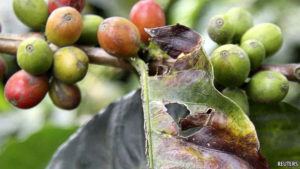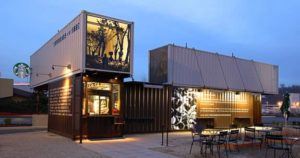Starbucks is hit hard by climate change…and punches back.

Starbucks is fighting back against climate change on multiple fronts to promote sustainable practices and bolster their position in the market.
The Unmistakable Link Between Coffee and Climate Change
Many would argue that the most important fuel of the American 20th century is not petroleum or natural gas but is instead coffee, the fuel that drives productivity from the classroom to the boardroom. However, the supply of this precious resources is increasingly at risk as the possible implications of climate change are realized. A quorum of scientists has proved and agreed upon the fact that the climate of our planet is changing due to the increasing presence of greenhouse gases (primarily CO2 emitted during the combustion of fossil fuels). While the idea that this will cause long-term global warming is heavily debated, empirical evidence suggests that, at least in the short term, the earth is experiencing an upward trend in temperatures. This trend is and will continue to affect climate and rain patterns as well as crop yields. The threat is very evident to Starbucks, the world’s leading seller of coffee, and they have already begun to take steps to bolster their supply chain, improve internal sustainability, and lobby Congress and the White House for action.

Positively Influencing the Supply Chain
To address the issues within their supply chain, Starbucks has partnered with growers in two primary ways. First, they have set standards for suppliers labeled C.A.F.E. (Coffee and Farmer Equity) Practices, outlining methods of using tree to shade and provide nutrients to the soil as well as other soil enriching best practices. In doing so, Starbucks expects to improve farmers’ crop yields and protect their investment into this network of coffee bean suppliers [1]. Second, in 2014 Starbucks purchased Hacienda Alsacia, a coffee farm in Costa Rica, and transformed it into a research and development center. At this facility, researchers work alongside farmers to cultivate more coffee varietals to resist fungal “coffee rust” attacks (pictured above), improve best-growing practices, and understand the growing challenge of climate change at the local level [2].

Look Inward and Improve the Bottom Line
Starbucks has also looked internally to find ways in which they can operate more sustainably. For instance, they have reduced store water usage by 26.5% over the period of 2008-2015 through plumbing and store upgrades, lowering operating expenses and increasing their bottom line simultaneously [2]. They have also improved energy conservation at many stores by installing and maintaining energy management systems, dashboards designed to optimize full-spectrum energy operations in commercial and industrial facilities. Finally, in 2008 Starbucks committed to obtaining LEED certification for all of its new stores and incorporating LEED building design into existing stores, reducing the carbon footprint of each of these stores. Currently, their portfolio contains an industry-leading 1000+ LEED-certified stores. Within this portfolio is the unique Reclamation Drive-Thru (pictured above), a Starbucks store made of reclaimed shipping containers which is capable of being disassembled and relocated to meet shifting demand [2]. By combining these efforts, along with several other minor initiatives relating to waste mitigation and paper product sourcing, Starbucks has set an impressive example of sustainable operations for other high-profile companies to emulate.
Leveraging Their Influence to Shape Policy
Looking external of their supply chain and operations, Starbuck has also been a strong advocate for legislation that addresses climate changes and its consequences. They were a founding member of BICEP (Business for Innovative Climate and Energy Policy), a government lobbying group of over 365 member-companies that advocates for transitioning the US economy from carbon-based to renewable, sustainable energy sources [3]. Starbucks is also a member of the RE100 coalition, a group of influential companies committed to sourcing 100% of their energy demands from renewable sources [4]. By joining groups and coalitions such as BICEP and RE100, Starbucks can leverage their influence to positively influence public policy on energy and climate change.
Future Actions
In looking to the future, Starbucks should continue to cultivate best growing practices through partnerships and research. I would also recommend that, as demand grows, they look for producers in climates more suited to effectively growing coffee beans. While the costs to switch suppliers will be substantial initially, they cannot afford to remain idle while the price of their primary raw material grows. Lastly, they should also remain committed to leveraging their partnerships to influence public policy dealing with climate change. Unfortunately, coalitions such as RE100 are often ambiguous on timelines for reaching goals. I would like to see Starbucks committing to a date by which they plan to achieve their goal of sourcing 100% of their energy from renewable sources, especially as they continue to grow their base of stores. Coupling responsible business practices with progressive public policy is important in reducing the implications of climate change.
Word Count (769)
Sources:
[1] Starbucks C.A.F.E. Practices Global Scorecard, Version 3.3 (Dec 2014), http://globalassets.starbucks.com/assets/4a67ce15e63b4ea18461ff65a 540feb3.pdf
[2] Environment: Pioneering Sustainable Solutions, Starbucks, 2016 (http://www.starbucks.com/responsibility/environment)
[3] Business for Innovative Climate and Energy Policy Principles (https://www.ceres.org/bicep/principles)
[4] The RE 100 (http://there100.org/re100)
Image Sources (in order)
[1] [Featured] http://www.starbucks.com/responsibility/sourcing/coffee
[2] Bitter Grounds: The Woes of Coffee Farmers, The Economist, Sept 15, 2012.
[3] http://www.starbucks.com/responsibility/environment/leed-certified-stores



Hey Greg!
– Well written, I did enjoy your pithy humour. As you may have predicted, I was indeed working through my third Nespresso of the day as I read your paper.
– I did find some extra studies which might have bolstered your post. You mentioned the causal link between humans/carbon emissions and long-term global warming – there are some irrefutable facts behind this. Recent meta-analyses have indicated that over 97% of peer-reviewed scientific literature agree that humans & carbon emissions are responsible for global warming. Take a look at these two papers: http://iopscience.iop.org/article/10.1088/1748-9326/11/4/048002/meta (2016) and http://iopscience.iop.org/article/10.1088/1748-9326/8/2/024024/meta (2013)
– One perspective that you might consider is where Starbucks fall short in their sustainability efforts. Another post from a classmate in section D “Starbucks: Practicing what it preaches when it comes to climate change?” concluded that Starbucks’ overall carbon emissions had gone up in 2015 as they introduced more stores and heated food (the latter requires far more energy to store and prepare). Do you think Starbucks should hold itself more accountable to sustainability in terms of overall strategic decisions like this? Where do you think the trade-off lies between sustainability and profitability?
Greg, an interesting perspective you provide. As someone who also read about the Starbucks situation with climate change, I was wondering if you thought about alternatives beyond the coffee operations. From my research, it seems like worst case, the prices of coffee can go really high, and I believe it’s unlikely consumers will start to pay couple more times the price for a cup of coffee. One thing during my research that I kept wondering was what else can Starbucks do that is really game changing. There is always the question of controlling the supply chain (vertical integration) as we explored in recent TOM Classes, which would be interesting as they could potentially control the newer-age technology to coffee production. However, I’d be interested to get your thoughts on the fact that they may have to diversify their product portfolio and drive more sales through non-coffee based products. This would definitely be interesting because they are a coffee company after all, but if history does repeat itself, many companies started off in one product-line and pivoted completely. In the worst case scenario, what do you think the Starbucks of the future could look like?
Greg, thanks for the article. Was curious about the investments in water usage reduction in Starbucks stores – do they think this is a self-contained investment with a payback period, or is it more for the overall mission / good PR? If the former, I’m curious just how much water they use, since water is so cheap that any substantial investment with a reduction in water use feels like the payback period would be prohibitively long. If it’s the latter, it’s interesting that as a consumer this is the first time I’m hearing about it. More broadly, has Starbucks taken steps to communicate these actions to consumers in a targeted way? I know their fair trade coffee was a big sticking point for them, but curious whether they view these as having demand effects in general.